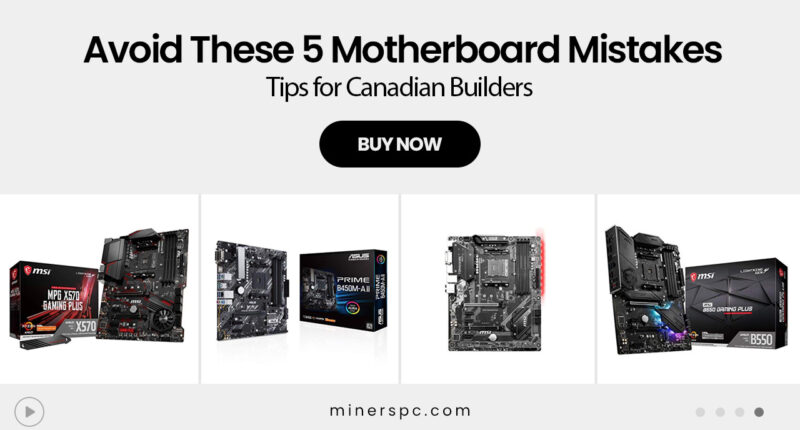When it comes to building your own PC in Canada, your motherboard can either be the rock-solid foundation for years of seamless performance—or a costly, frustrating misstep. And while it’s tempting to focus on flashy GPUs or high-speed SSDs, skipping over key motherboard details can seriously bottleneck your system or worse, force an early upgrade.
Whether you’re a first-time builder in Toronto or a seasoned enthusiast in Vancouver, knowing what not to do can save you time, money, and regret. In this guide, we’ll walk through five of the most common motherboard mistakes Canadian builders make—and show you how to avoid them.
Let’s dive in.
1. Mismatching the CPU and Motherboard Socket
One of the most common blunders? Choosing a CPU that doesn’t match your motherboard’s socket type. For example, pairing an Intel Core i7-11700K with an AM4 motherboard just won’t work—no amount of BIOS magic will save you.
What to do instead: Always double-check the socket compatibility. If you’re going AMD, look for AM4 or AM5 boards depending on your processor generation. Intel users should match their chips with LGA 1200, 1700, or 1151 depending on the CPU family.
Take the MSI MPG B550 Gaming Plus, for instance. It’s a great ATX board designed specifically for AMD’s AM4 socket and supports Ryzen 3000 and 5000 series CPUs. You get PCIe 4.0 support, M.2 slots, and USB 3.2 Gen 2 for solid futureproofing.
Expert Tip: Always check the manufacturer’s CPU support list—even within the same socket, not all CPUs are supported out of the box without a BIOS update.
2. Overlooking Form Factor and Case Compatibility
It’s easy to fall in love with a feature-packed ATX motherboard… until you realize your mid-tower case only supports Micro ATX.
Form factor matters more than most people realize. ATX, Micro ATX (mATX), and Mini ITX boards differ in size, port layout, and expansion slots. Choose one that fits your case and needs.
For compact builds, the ASRock B450M-HDV R4.0 is a reliable Micro ATX board that doesn’t sacrifice on essentials—support for AMD Ryzen chips, M.2 storage, and decent power delivery. Meanwhile, builders with more space can consider the MSI Performance Gaming X570, which leverages full ATX real estate to deliver extra PCIe slots and heatsinks.
Real Scenario: A Canadian student built a PC for dorm use but had to return the ATX board because it didn’t fit his compact case. A Micro ATX like the ASUS Prime B450M-A II would’ve saved him the hassle—and shipping fees.
3. Ignoring VRM Quality and Power Delivery
If you’re using a high-performance CPU—especially for gaming or content creation—don’t skimp on power delivery. VRMs (Voltage Regulator Modules) feed your CPU, and poor-quality ones can cause thermal throttling, crashes, or limit your overclocking potential.
Motherboards like the ROG Strix Z590-E Gaming WiFi 6E shine here. It features 14+2 power stages, ideal for Intel 11th/10th Gen CPUs. Combine that with Thunderbolt 4, Wi-Fi 6E, and four M.2 slots, and you have a powerhouse for intensive tasks.
On the AMD side, the MSI B450 TOMAHAWK Max II is a community-favourite known for its sturdy VRMs. It’s perfect for overclockers running Ryzen 5 or Ryzen 7 CPUs on a budget.
Expert Insight: If your CPU pulls 100+ watts under load, don’t rely on a budget board with a barebones VRM layout. You’ll regret it during those long gaming sessions or while rendering 4K video.
4. Failing to Future-Proof Connectivity
In the fast-moving world of PC tech, standards change quickly. Buying a board without USB 3.2 Gen 2, M.2 NVMe support, or PCIe 4.0 means you’ll miss out on today’s (and tomorrow’s) performance perks.
For example, the ASUS TUF Gaming B450-PLUS II includes USB 3.2 Gen 2, support for high-speed RAM, and even AI noise cancelling for creators. Similarly, the GIGABYTE Z390 AORUS PRO Wi-Fi supports Intel Optane Memory and includes onboard Wi-Fi—great for builders without wired connections.
Pro Tip: Even if you don’t need Wi-Fi or PCIe Gen 4 now, boards like the MSI B450 GAMING PLUS Max offer these features to keep you ahead of the curve without having to upgrade again next year.
5. Not Considering BIOS and Update Support
BIOS compatibility can make or break your build, especially if you’re pairing newer CPUs with older motherboards. Many builders in Canada assume the board is plug-and-play—only to find out they need an older CPU to update the BIOS first.
Boards with BIOS Flashback like the ASUS Prime B450M-A II or ASUS TUF Gaming B450-PLUS II let you update firmware without a CPU installed—a game-changer for future upgrades.
Likewise, the Asus PRIME B365M-A supports BIOS updates and is well-suited for Intel 8th and 9th Gen processors, offering great stability for mid-range builds.
Canadian Context: With limited access to computer repair stores in more rural provinces, choosing a board with an easy BIOS update feature could save you from long shipping times or service delays.
Final Thoughts: Get It Right the First Time
Choosing the right motherboard is less about flashy RGB and more about compatibility, reliability, and long-term value. Avoiding these five common mistakes can save you hours of troubleshooting, and hundreds of dollars in replacements or missed features.
From solid all-rounders like the MSI MPG B550 Gaming Plus to upgrade-friendly options like the ROG Strix Z590-E, picking the right board starts with asking the right questions—and being honest about your future plans.
Looking for the perfect pick? Explore the top recommendations below while they’re still available – these won’t stay in stock for long.
















![Best Prebuilt PCs in Canada for Work, School & Gaming [2025 Guide]](https://www.minerspc.com/wp-content/uploads/2025/07/best-prebuilt-pcs-in-canada-for-work-school-gaming-2025-guide-260x140.jpg)


